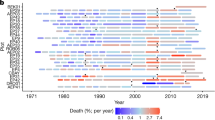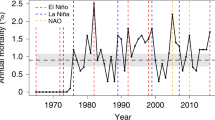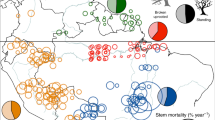Abstract
Drought- and heat-driven tree mortality, along with associated insect outbreaks, have been observed globally in recent decades and are expected to increase in future climates. Despite its potential to profoundly alter ecosystem carbon and water cycles, how tree mortality scales up to ecosystem functions and fluxes is uncertain. We describe a framework for this scaling where the effects of mortality are a function of the mortality attributes, such as spatial clustering and functional role of the trees killed, and ecosystem properties, such as productivity and diversity. We draw upon remote-sensing data and ecosystem flux data to illustrate this framework and place climate-driven tree mortality in the context of other major disturbances. We find that emerging evidence suggests that climate-driven tree mortality impacts may be relatively small and recovery times are remarkably fast (~4 years for net ecosystem production). We review the key processes in ecosystem models necessary to simulate the effects of mortality on ecosystem fluxes and highlight key research gaps in modeling. Overall, our results highlight the key axes of variation needed for better monitoring and modeling of the impacts of tree mortality and provide a foundation for including climate-driven tree mortality in a disturbance framework.




Similar content being viewed by others
References
Adams HD, Macalady AK, Breshears DD et al. 2010. Climate-induced tree mortality: earth system consequences. Eos Trans Am Geophys Union 91:153–4.
Adams HD, Luce CH, Breshears DD et al. 2012. Ecohydrological consequences of drought-and infestation-triggered tree die-off: insights and hypotheses. Ecohydrology 5:145–59.
Allen CD, Macalady AK, Chenchouni H et al. 2010. A global overview of drought and heat-induced tree mortality reveals emerging climate change risks for forests. For Ecol Manag 259:660–84.
Amiro BD, Barr AG, Barr JG, Black TA, Bracho R. 2010. Ecosystem carbon dioxide fluxes after disturbance in forests of North America. J Geophys Res 115:G00K02.
Anderegg WR. 2014. Spatial and temporal variation in plant hydraulic traits and their relevance for climate change impacts on vegetation. New Phytol 205:1008–14.
Anderegg WRL, Anderegg LDL, Sherman C, Karp DS. 2012. Effects of widespread drought-induced aspen mortality on understory plants. Conserv Biol 26:1082–90.
Anderegg WRL, Kane JM, Anderegg LDL. 2013a. Consequences of widespread tree mortality triggered by drought and temperature stress. Nat Clim Chang 3:30–6.
Anderegg WRL, Plavcová L, Anderegg LDL, Hacke UG, Berry JA, Field CB. 2013b. Drought’s legacy: multiyear hydraulic deterioration underlies widespread aspen forest die-off and portends increased future risk. Glob Chang Biol 19:1188–96.
Anderegg WR, Anderegg LD, Berry JA, Field CB. 2014. Loss of whole-tree hydraulic conductance during severe drought and multi-year forest die-off. Oecologia 175:11–23.
Anderegg WRL, Schwalm C, Biondi F et al. 2015a. Pervasive drought legacies in forest ecosystems and their implications for carbon cycle models. Science 349:528–32.
Anderegg WRL, Flint Alan, Huang Cho-ying et al. 2015b. Tree mortality predicted from drought-induced vascular damage. Nat Geosci 8:367–71.
Beard KH, Vogt KA, Vogt DJ et al. 2005. Structural and functional responses of a subtropical forest to 10 years of hurricanes and droughts. Ecol Monogr 75:345–61.
Biederman JA, Harpold AA, Gochis DJ, Ewers BE, Reed DE, Papuga SA, Brooks PD. 2014. Increased evaporation following widespread tree mortality limits streamflow response. Water Resour Res 50:5395–409.
Brando PM, Nepstad DC, Davidson EA, Trumbore SE, Ray D, Camargo P. 2008. Drought effects on litterfall, wood production and belowground carbon cycling in an Amazon forest: results of a throughfall reduction experiment. Philos Trans R Soc B 363:1839–48.
Breda N, Huc R, Granier A, Dreyer E. 2006. Temperate forest trees and stands under severe drought: a review of ecophysiological responses, adaptation processes and long-term consequences. Ann For Sci 63:625–44.
Brienen RJW, Phillips OL, Feldpausch TR et al. 2015. Long-term decline of the Amazon carbon sink. Nature 519:344–8.
Brown M, Black TA, Nesic Z et al. 2010. Impact of mountain pine beetle on the net ecosystem production of lodgepole pine stands in British Columbia. Agric For Meteorol 150:254–64.
Brown MG, Black TA, Nesic Z et al. 2012. The carbon balance of two lodgepole pine stands recovering from mountain pine beetle attack in British Columbia. Agric For Meteorol 153:82–93.
Carvalhais N, Forkel M, Khomik M et al. 2014. Global covariation of carbon turnover times with climate in terrestrial ecosystems. Nature 513:213–17.
Chambers JQ, Negron-Juarez RI, Marra DM et al. 2013. The steady-state mosaic of disturbance and succession across an old-growth Central Amazon forest landscape. Proc Nat Acad Sci 110:3949–54.
Ciais P, Reichstein M, Viovy N et al. 2005. Europe-wide reduction in primary productivity caused by the heat and drought in 2003. Nature 437:529–33.
da Costa ACL, Galbraith D, Almeida S et al. 2010. Effect of 7 yr of experimental drought on vegetation dynamics and biomass storage of an eastern Amazonian rainforest. New Phytol 187:579–91.
Dore S, Montes-Helu M, Hart SC et al. 2012. Recovery of ponderosa pine ecosystem carbon and water fluxes from thinning and stand-replacing fire. Glob Chang Biol 18:3171–85.
Edburg SL, Hicke JA, Brooks PD et al. 2012. Cascading impacts of bark beetle-caused tree mortality on coupled biogeophysical and biogeochemical processes. Front Ecol Environ 10:416–24.
Espírito-Santo FDB, Gloor M, Keller M, Malhi Y, Saatchi S, Nelson B, Junior RCO, Pereira C, Lloyd J, Frolking S, Palace M, Shimabukuro YE, Duarte V, Mendoza AM, López-González G, Baker TR, Feldpausch TR, Brienen RJW, Asner GP, Boyd DS, Phillips OL. 2014. Size and frequency of natural forest disturbances and the Amazon forest carbon balance. Nat commun 5:3434. doi:10.1038/ncomms4434.
Fisher R, McDowell N, Purves D et al. 2010. Assessing uncertainties in a second-generation dynamic vegetation model caused by ecological scale limitations. New Phytol 187:666–81.
Folke C, Carpenter S, Walker B, Scheffer M, Elmqvist T, Gunderson L, Holling CS. 2004. Regime shifts, resilience, and biodiversity in ecosystem management. Ann Rev Ecol Evol Syst 35:557–81.
Frank JM, Massman WJ, Ewers BE, Huckaby LS, Negrón JF. 2014. Ecosystem CO2/H2O fluxes are explained by hydraulically limited gas exchange during tree mortality from spruce bark beetles. J Geophys Res 119:1195–215.
Frank D, Reichstein M, Bahn M et al. 2015. Effects of climate extremes on the terrestrial carbon cycle: concepts, processes and potential future impacts. Glob Chang Biol 21:2861–80.
Franklin JF, Forman RT. 1987. Creating landscape patterns by forest cutting: ecological consequences and principles. Landsc Ecol 1:5–18.
Franklin JF, Shugart HH, Harmon ME. 1987. Tree death as an ecological process. BioScience 37:550–6.
Fyllas NM, Gloor E, Mercado LM et al. 2014. Analysing Amazonian forest productivity using a new individual and trait-based model (TFS v. 1). Geosci Model Dev 7:1251–69.
Galbraith D, Malhi Y, Affum-Baffoe K et al. 2013. Residence times of woody biomass in tropical forests. Plant Ecol Divers 6:139–57.
Gatti L, Gloor M, Miller J et al. 2014. Drought sensitivity of Amazonian carbon balance revealed by atmospheric measurements. Nature 506:76–80.
Giuggiola A, Bugmann H, Zingg A, Dobbertin M, Rigling A. 2013. Reduction of stand density increases drought resistance in xeric Scots pine forests. For Ecol Manag 310:827–35.
Goetz SJ, Bond-Lamberty B, Law BE et al. 2012. Observations and assessment of forest carbon dynamics following disturbance in North America. J Geophys Res Biogeosci 2005–2012:117.
Gough CM, Hardiman BS, Nave LE et al. 2013. Sustained carbon uptake and storage following moderate disturbance in a Great Lakes forest. Ecol Appl 23:1202–15.
Guardiola-Claramonte M, Troch PA, Breshears DD, Huxman TE, Switanek MB, Durcik M, Cobb NS. 2011. Decreased streamflow in semi-arid basins following drought-induced tree die-off: a counter-intuitive and indirect climate impact on hydrology. J Hydrol 406:225–33.
Hansen M, Potapov P, Moore R et al. 2013. High-resolution global maps of 21st-century forest cover change. Science 342:850–3.
Hansen EM, Amacher MC, Van Miegroet H, Long JN, Ryan MG. 2015. Carbon dynamics in central US rockies lodgepole pine type after mountain pine beetle outbreaks. For Sci 61:665–79.
Harmon ME, Hua C. 1991. Coarse woody debris dynamics in two old-growth ecosystems. BioScience 41:604–10.
Harmon ME, Bond-Lamberty B, Tang J, Vargas R. 2011. Heterotrophic respiration in disturbed forests: a review with examples from North America. J Geophys Res 2005–2012:116.
Hicke JA, Allen CD, Desai AR et al. 2012. Effects of biotic disturbances on forest carbon cycling in the United States and Canada. Glob Chang Biol 18:7–34.
Hicke JA, Meddens AJ, Allen CD, Kolden CA. 2013. Carbon stocks of trees killed by bark beetles and wildfire in the western United States. Environ Res Lett 8:035032.
Huang C-Y, Anderegg WRL. 2012. Large drought-induced aboveground live biomass losses in southern Rocky Mountain aspen forests. Glob Chang Biol 18:1016–27.
Krofcheck DJ, Eitel JU, Vierling LA et al. 2014. Detecting mortality induced structural and functional changes in a piñon-juniper woodland using Landsat and RapidEye time series. Remote Sens. Environ. 151:102–13.
Kurz WA, Dymond CC, Stinson G et al. 2008. Mountain pine beetle and forest carbon feedback to climate change. Nature 452:987–90.
López BC, Gracia CA, Sabaté S, Keenan T. 2009. Assessing the resilience of Mediterranean holm oaks to disturbances using selective thinning. Acta Oecologica 35:849–54.
Mackay DS, Roberts DE, Ewers BE, Sperry JS, McDowell NG, Pockman WT. 2015. Interdependence of chronic hydraulic dysfunction and canopy processes can improve integrated models of tree response to drought. Water Resour Res. 51:6156–76.
van Mantgem PJ, Stephenson NL, Byrne JC et al. 2009. Widespread increase of tree mortality rates in the Western United States. Science 323:521–4.
Martínez-Vilalta J, Vanderklein D, Mencuccini M. 2007. Tree height and age-related decline in growth in Scots pine (Pinus sylvestris L.). Oecologia 150:529–44.
Martínez-Vilalta J, Piñol J, Beven K. 2002. A hydraulic model to predict drought-induced mortality in woody plants: an application to climate change in the Mediterranean. Ecol Model 155:127–47.
Matheny AM, Bohrer G, Vogel CS, Morin TH, He L, Frasson RP de M, Mirfenderesgi G, Schäfer KV, Gough CM, Ivanov VY, Curtis PS. 2014. Species-specific transpiration responses to intermediate disturbance in a northern hardwood forest. J Geophys Res Biogeosci 119:2292–2311.
McDowell NG, Beerling DJ, Breshears DD, Fisher RA, Raffa KF, Stitt M. 2011. The interdependence of mechanisms underlying climate-driven vegetation mortality. Trends Ecol Evolut 26:523–32.
McDowell NG, Fisher RA, Xu C et al. 2013. Evaluating theories of drought-induced vegetation mortality using a multimodel-experiment framework. New Phytol 200:304–21.
Merlin M, Perot T, Perret S, Korboulewsky N, Vallet P. 2015. Effects of stand composition and tree size on resistance and resilience to drought in sessile oak and Scots pine. For Ecol Manag 339:22–33.
Miller SD, Goulden ML, Hutyra LR et al. 2011. Reduced impact logging minimally alters tropical rainforest carbon and energy exchange. Proc Nat Acad Sci 108:19431–5.
Mkhabela MS, Amiro BD, Barr AG et al. 2009. Comparison of carbon dynamics and water use efficiency following fire and harvesting in Canadian boreal forests. Agric For Meteorol 149:783–94.
Moore DJP, Trahan NA, Wilkes P et al. 2013. Persistent reduced ecosystem respiration after insect disturbance in high elevation forests. Ecol Lett 16:731–7.
Morin X, Fahse L, Mazancourt C, Scherer-Lorenzen M, Bugmann H. 2014. Temporal stability in forest productivity increases with tree diversity due to asynchrony in species dynamics. Ecol Lett 17:1526–35.
Nave LE, Gough CM, Maurer KD et al. 2011. Disturbance and the resilience of coupled carbon and nitrogen cycling in a north temperate forest. J Geophys Res 116:4016.
Nepstad DC, Tohver IM, Ray D, Moutinho P, Cardinot G. 2007. Mortality of large trees and lianas following experimental drought in an Amazon forest. Ecology 88:2259–69.
Norton U, Ewers BE, Borkhuu B, Brown NR, Pendall E. 2015. Soil nitrogen five years after bark beetle infestation in lodgepole pine forests. Soil Sci Soc Am J 79:282–93.
Odum EP. 1969. The strategy of ecosystem development. Science 164:262–70.
Pausas JG, Llovet J, Rodrigo A, Vallejo R. 2009. Are wildfires a disaster in the Mediterranean basin?—A review. Int J Wildland Fire 17:713–23.
Peng C, Ma Z, Lei X et al. 2011. A drought-induced pervasive increase in tree mortality across Canada’s boreal forests. Nat Clim Chang 1:467–71.
Pfeifer EM, Hicke JA, Meddens AJ. 2011. Observations and modeling of aboveground tree carbon stocks and fluxes following a bark beetle outbreak in the western United States. Glob Chang Biol 17:339–50.
Phillips OL, van der Heijden G, Lewis SL et al. 2010. Drought-mortality relationships for tropical forests. New Phytol 187:631–46.
Powell TL, Galbraith DR, Christoffersen BO et al. 2013. Confronting model predictions of carbon fluxes with measurements of Amazon forests subjected to experimental drought. New Phytol 200:350–65.
Raz-Yaseef N, Rotenberg E, Yakir D. 2010. Effects of spatial variations in soil evaporation caused by tree shading on water flux partitioning in a semi-arid pine forest. Agric For Meteorol 150:454–62.
Reed DE, Ewers BE, Pendall E. 2014. Impact of mountain pine beetle induced mortality on forest carbon and water fluxes. Environ Res Lett 9:105004.
Reich PB. 2014. The world-wide “fast–slow” plant economics spectrum: a traits manifesto. J Ecol 102:275–301.
Rhoades CC, McCutchan JH, Cooper LA et al. 2013. Biogeochemistry of beetle-killed forests: Explaining a weak nitrate response. Proc Nat Acad Sci 110:1756–60.
Roman DT, Novick KA, Brzostek ER, Dragoni D, Rahman F, Phillips RP. 2015. The role of isohydric and anisohydric species in determining ecosystem-scale response to severe drought. Oecologia 179:641–54.
Rowland L, Hill TC, Stahl C et al. 2014. Evidence for strong seasonality in the carbon storage and carbon use efficiency of an Amazonian forest. Glob Chang Biol 20:979–91.
Rowland L, Harper A, Christoffersen BO et al. 2015. Modelling climate change responses in tropical forests: similar productivity estimates across five models, but different mechanisms and responses. Geosci Model Dev 8:1097–110.
Schwalm CR, Williams CA, Schaefer K et al. 2012. Reduction in carbon uptake during turn of the century drought in western North America. Nat Geosci 5:551–6.
Slik JW, Paoli G, McGuire K et al. 2013. Large trees drive forest aboveground biomass variation in moist lowland forests across the tropics. Glob Ecol Biogeogr 22:1261–71.
Smith MD, Knapp AK, Collins SL. 2009. A framework for assessing ecosystem dynamics in response to chronic resource alterations induced by global change. Ecology 90:3279–89.
Speckman HN, Frank JM, Bradford JB, Miles BL, Massman WJ, Parton WJ, Ryan MG. 2014. Forest ecosystem respiration estimated from eddy covariance and chamber measurements under high turbulence and substantial tree mortality from bark beetles. Glob Chang Biol 21:708–21.
Sperry JS, Adler FR, Campbell GS, Comstock JP. 1998. Limitation of plant water use by rhizosphere and xylem conductance: results from a model. Plant Cell Environ 21:347–59.
Stephenson NL, van Mantgem PJ. 2005. Forest turnover rates follow global and regional patterns of productivity. Ecol Lett 8:524–31.
Stephenson NL, Das AJ, Condit R et al. 2014. Rate of tree carbon accumulation increases continuously with tree size. Nature 507:90–3.
Stuart-Haëntjens E, Curtis PS, Fahey RT, Vogel CS, Gough CM. 2015. Net primary production of a temperate deciduous forest exhibits a threshold response to increasing disturbance severity. Ecology. 96:2478–87.
Templeton BS, Seiler JR, Peterson JA, Tyree MC. 2015. Environmental and stand management influences on soil CO2 efflux across the range of loblolly pine. For Ecol Manag 355:15–23.
Turner MG, Romme WH, Gardner RH, Hargrove WW. 1997. Effects of fire size and pattern on early succession in Yellowstone National Park. Ecol Monogr 67:411–33.
White PS, Pickett ST. 1985. Natural disturbance and patch dynamics: an introduction. The ecology of natural disturbance and patch dynamics. New York: Academic Press. pp 3–13.
Acknowledgments
We thank the International Interdisciplinary Tree Mortality Workshop in Jena, Germany, for the discussions that led to the manuscript. W.R.L.A. was supported in part by a National Oceanic and Atmospheric Administration Climate and Global Change Postdoctoral fellowship, administered by the University Corporation of Atmospheric Research and an NSF Macrosystems Biology Grant (DEB EF-1340270). J.M.V. was supported in part by Spanish grant CGL2013-46808-R, by AGAUR (2014 SGR 453 grant), and by an ICREA Acadèmia Excellence in Research award. The postdoctoral position of M.C. was funded by the Swiss National Science Foundation (Project 140968). CyH was partially sponsored by Ministry of Science and Technology (MOST 103-2119-M-002-016-) and National Taiwan University (EcoNTU: 10R70604-2). R.S.S. was supported in part by postdoctoral fellowship of (FEDER)-Programa de Fortalecimiento en I+D+i de las Universidades 2014–2015 de la Junta de Andalucía, by CoMo-ReAdapt (CGL2013-48843-C2-1-R Spanish project), and his work has been carried out under the framework of the COST FP1106 network STReESS.
Author information
Authors and Affiliations
Corresponding author
Additional information
Author Contributions
WRLA, JMV, MC, JJC, BE, DG, AG, RG, CH, SL, TLP, LR, RSS, and VT conceived of the study. WRLA, JMV, MC, and CY performed research. WRLA analyzed the data. WRLA, JMV, MC, JJC, BE, DG, AG, RG, CH, SL, TLP, LR, RSS, and VT wrote the paper.
Electronic supplementary material
Below is the link to the electronic supplementary material.
Rights and permissions
About this article
Cite this article
Anderegg, W.R.L., Martinez-Vilalta, J., Cailleret, M. et al. When a Tree Dies in the Forest: Scaling Climate-Driven Tree Mortality to Ecosystem Water and Carbon Fluxes. Ecosystems 19, 1133–1147 (2016). https://doi.org/10.1007/s10021-016-9982-1
Received:
Accepted:
Published:
Issue Date:
DOI: https://doi.org/10.1007/s10021-016-9982-1




